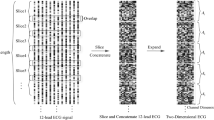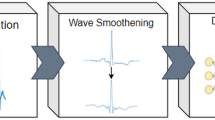Abstract
Electrocardiogram (ECG) is one among the most common detecting techniques in the analysis and detection of cardiac arrhythmia adopted due to its cost efficiency and simplicity. In a clinical routine, ECG database is collected on daily basis and these databases are reviewed manually. Along with other conventional methods, various approaches using machine learning has been proposed in the past few years. But these would require in-depth knowledge on several parameters and pre-processing techniques in the specific domain. This study is aimed at implementing a more reliable deep learning model that has the capacity to diagnose arrhythmia from a database with 109,446 samples in 5 different categories. In our proposed work, we have used deep learning methodologies for the diagnosis and detection of cardiac arrhythmia automatically. Balancing the biasedness in the waveforms from MIT-BIH arrhythmia database, model is developed. MIT-BIH arrhythmia database with the ECG waveforms promises good accuracy. This automated prediction of the disease using CNN and ResNet-18 architectures are compared in terms of accuracy. CNN has accuracy approximately 97.86% and 98.14% for improved ResNet-18. Also, a comparative analysis is done with the proposed model and already existing techniques. Several limitations and future opportunities are also reviewed. We believe it can be used considerably for cardiac arrhythmia prediction worldwide. Based on the results obtained, ResNet-18 architecture can be used as an efficient procedure, that reduces the burden of training a deep convolutional neural network from start, resulting in a technique that is simple to use.












Similar content being viewed by others
Availability of data and material
The data samples have been reasonably requested.
Code availability
The relevant code with the manuscript is also available and would be available, if will be asked to do so later.
References
Anand R, Veni S, Geetha P, Subramoniam SR (2021) Extended morphological profiles analysis of airborne hyperspectral image classification using machine learning algorithms. Int J Intell Netw 2:1–6
Anand R, Khan B, Nassa VK, Pandey D, Dhabliya D, Pandey BK, Dadheech P (2023) Hybrid convolutional neural network (CNN) for Kennedy space center hyperspectral image. Aerospace Syst 6(1):71–78
Anh D, Krishnan S, Bogun F (2006) Accuracy of electrocardiogram interpretation by cardiologists in the setting of incorrect computer analysis. J Electrocardiol 39(3):343–345
Alfaras M, Soriano MC, Ortín S (2019) A fast machine learning model for ECG-based heartbeat classification and arrhythmia detection. Frontiers in Physics 103
Baloglu UB, Talo M, Yildirim O, Tan RS, Acharya UR (2019) Classification of myocardial infarction with multi-lead ECG signals and deep CNN. Pattern Recogn Lett 122:23–30
Benjamin EJ, Virani SS, Callaway CW, Chamberlain AM, Chang AR, Cheng S, Chiuve SE, Cushman M, Delling FN, Deo R, de Ferranti SD (2018) Heart disease and stroke statistics—2018 update: a report from the American heart association. Circulation 137(12):e67–492
Boopathi S, Pandey BK, Pandey D (2023) Advances in artificial intelligence for image processing: techniques, applications, and optimization. Handbook of research on thrust technologies’ effect on image processing. IGI Global, pp 73–95
Connolly SJ, Eikelboom J, Joyner C, Diener HC, Hart R, Golitsyn S, Flaker G, Avezum A, Hohnloser SH, Diaz R, Talajic M (2011) Apixaban in patients with atrial fibrillation. N Engl J Med 364(9):806–817
David S, Duraipandian K, Chandrasekaran D, Pandey D, Sindhwani N, Pandey BK (2023) Impact of blockchain in healthcare system. Unleashing the Potentials of blockchain technology for healthcare industries. Academic Press, pp 37–57
Duan R, Mohammed S, Fiaidhi J (2019) Ensemble methods for ECG-based heartbeat classification. Int J Control Autom 12(4):29–46. https://doi.org/10.33832/ijca.2019.12.4.03
Ganeshkumar M, Ravi V, Sowmya V, Gopalakrishnan EA, Soman KP, Rupeshkumar M (2023) Two-stage deep learning model for automate detection and classification of lung diseases. Soft Comput 27(21):15563–15579
Gupta A, Anand R, Pandey D, Sindhwani N, Wairya S, Pandey BK, Sharma M (2021) Prediction of breast cancer using extremely randomized clustering forests (ERCF) technique: prediction of breast cancer. Int J Distrib Syst Technol (IJDST) 12(4):1–15
Houssein EH, Ibrahim IE, Neggaz N, Hassaballah M, Wazery YM (2021) An efficient ECG arrhythmia classification method based on Manta ray foraging optimization. Expert Syst Appl 181:115131
https://www.who.int/en/news-room/fact-sheets/detail/cardiovascular-diseases-(cvds)
Jaber S, Nussinovitch U, Stahi T, Arnson Y (2022) Association between T wave morphology parameters and abnormal cardiac SPECT imaging. J Electrocardiol 1(70):65–69
Jun TJ, Nguyen HM, Kang D, Kim D, Kim D, and Kim Y (2018) ECG arrhythmia classification using a 2-D convolutional neural network. https://arxiv.org/abs/1804.06812.
Kanani P, Padole M (2020) ECG heartbeat arrhythmia classification using time-series augmented signals and deep learning approach. Procedia Comput Sci 171:524–531
Kirubasri G, Sankar S, Pandey D, Pandey BK, Nassa VK, Dadheech P (2022) Software-defined networking-based Ad hoc networks routing protocols. Software defined networking for Ad Hoc networks. Springer International Publishing, Cham, pp 95–123
Kumar Pandey B, Pandey D, Nassa VK, Ahmad T, Singh C, George AS, Wakchaure MA (2021) Encryption and steganography-based text extraction in IoT using the EWCTS optimizer. Imaging Sci J 69(1–4):38–56
Li H, An Z, Zuo S, Zhu W, Cao L, Mu Y, Song W, Mao Q, Zhang Z, Li E, García JD (2022) Classification of electrocardiogram signals with waveform morphological analysis and support vector machines. Med Biol Eng Compu 60(1):109–119
Li D, Zhang J, Zhang Q, Wei X (2017) Classification of ECG signals based on 1d convolution neural network. In: 2017 IEEE 19th international conference on e-health networking, applications and services (Healthcom), pp. 1–6. IEEE
Liu W, Huang Q, Chang S, Wang H, He J (2018) Multiple-feature-branch convolutional neural network for myocardial infarction diagnosis using electrocardiogram. Biomed Signal Process Control 45:22–32
Mathunjwa BM, Lin Y-T, Lin C-H, Abbod MF, Shieh J-S (2021) ECG arrhythmia classification by using a recurrence plot and convolutional neural network. Biomed Signal Process Control 64:102262
Pandey D, Pandey BK (2022) An efficient deep neural network with adaptive galactic swarm optimization for complex image text extraction. Process mining techniques for pattern recognition. CRC Press, pp 121–137
Pandey BK, Pandey D (2023) Parametric optimization and prediction of enhanced thermoelectric performance in co-doped CaMnO3 using response surface methodology and neural network. J Mater Sci: Mater Electron 34(21):1589
Pandey D, Pandey BK, Wairya S (2021a) Hybrid deep neural network with adaptive galactic swarm optimization for text extraction from scene images. Soft Comput 25:1563–1580
Pandey BK, Pandey D, Wariya S, Agarwal G (2021b) A deep neural network-based approach for extracting textual images from deteriorate images. EAI Endorsed Trans Ind Netw Intell Syst 8(28):e3–e3
Papageorgiou, Vasileios E, Thomas Z, Georgios E, George T (2022) Analysis of digitalized ECG Signals based on artificial intelligence and spectral analysis methods specialized in ARVC. arXiv preprint arXiv:2203.00504
D. Pirova, B. Zaberzhinsky, and A. Mashkov (2020) Detecting heart 2 disease symptoms using machine learning methods. In: Proceedings of the information technology and nanotechnology (ITNT-2020), vol. 2667, pp. 260–263, Samara, Russia
Pławiak P (2018) Novel methodology of cardiac health recognition based on ECG signals and evolutionary-neural system. Exp Syst 92:334–349. https://doi.org/10.1016/j.eswa.2017.09.022
Pranav JV, Anand R, Shanthi T, Manju K, Veni S, Nagarjun S (2020) Detection and identification of COVID-19 based on chest medical image by using convolutional neural networks. Int J Intell Netw 1:112–118
Ramkumar G, Bhuvaneswari P, Radhika R, Saranya S, Vijayalakshmi S, Karpagam M, Wilfred F (2022) Implementation of machine learning mechanism for recognising prostate cancer through photoacoustic signal. Contrast Med Mol Imaging. https://doi.org/10.1155/2022/6862083
Ravi V, EA G, KP S (2023) Deep learning-based approach for multi-stage diagnosis of Alzheimer’s disease. Multimed Tools Appl 1:1–24
Revathi TK, Sathiyabhama B, Sankar S, Pandey D, Pandey BK, Dadeech P (2022) An intelligent model for coronary heart disease diagnosis. Netw Technol Smart Healthc: Innov Anal Approach. 1:234
Rosasco L, Vito ED, Caponnetto A, Piana M, Verri A (2004) Are loss functions all the same? Neural Comput 16(5):1063–1076
Saini DS, Khosla A (2013) QRS detection using K-nearest neighbor algorithm (KNN) and evaluation on standard ECG databases”. J Adv Res 4(4):331–344
Tripathi RP, Sharma M, Gupta AK, Pandey D, Pandey BK, Shahul A, George AH (2023) Timely prediction of diabetes by means of machine learning practices. Augment Hum Res 8(1):1
P. Walsh (2019) Support Vector Machine Learning for ECG Classification, CERC, Delhi, India
Xin-Mu LI, Xin-Yi GAO, Tse G, Shen-Da HONG, Kang-Yin CHEN, Guang-Ping LI, Tong LIU (2022) Electrocardiogram-based artificial intelligence for the diagnosis of heart failure: a systematic review and meta-analysis. J Geria Cardiol JGC 19(12):970
Xu SS, Mak MW, Cheung CC (2018) Towards end-to-end ECG classification with raw signal extraction and deep neural networks. IEEE J Biomed Health Inform 23(4):1574–1584
Yıldırım Ö, Pławiak P, Tan R-S, Acharya UR (2018) Arrhythmia detection using deep convolutional neural network with long duration ECG signals comput. Biol Med 102:411–420
Acknowledgements
The authors would like to express gratitude to Department of Technical Education and Chandigarh Group of Colleges, Landran, Punjab India.The authors would also like to thank to Vice Chancellor,Dr. A.P.J. Abdul Kalam Technical University, and Uttar Pradesh, India
Funding
The author(s) received no financial support for the research, authorship, and/or publication of this article.
Author information
Authors and Affiliations
Contributions
All authors approve the final manuscript.
Corresponding author
Ethics declarations
Conflict of interest
The authors declare that they have ‘no known conflict of interests or personal relationships’ that could have appeared to influence the work reported in this paper.
Ethical approval
Not Applicable (as the results of studies do not involve any human or animal).
Consent to participate
Not Applicable (as the results of studies do not involve any human or animal).
Consent for publication
Not Applicable (as the results of studies does not involve any human or animal).
Rights and permissions
Springer Nature or its licensor (e.g. a society or other partner) holds exclusive rights to this article under a publishing agreement with the author(s) or other rightsholder(s); author self-archiving of the accepted manuscript version of this article is solely governed by the terms of such publishing agreement and applicable law.
About this article
Cite this article
Anand, R., Lakshmi, S.V., Pandey, D. et al. An enhanced ResNet-50 deep learning model for arrhythmia detection using electrocardiogram biomedical indicators. Evolving Systems 15, 83–97 (2024). https://doi.org/10.1007/s12530-023-09559-0
Received:
Accepted:
Published:
Issue Date:
DOI: https://doi.org/10.1007/s12530-023-09559-0




